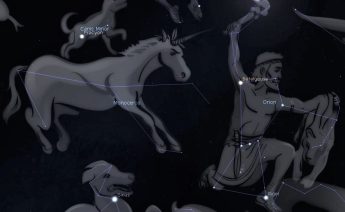This Week’s Sky at a Glance, 2025 Mar 15 – Mar 22
This Week’s Sky at a Glance, 2025 Mar 15 – Mar 22
As darkness settles this Monday evening, go out and raise a glass to the southwest and toast the constellation Orion, the mighty sky-hunter who on that day signs his name as O’Ryan. And if you had dusted off an Irish Rovers record during the day, perhaps you will be hunting the sky for some animals in their signature tune written by Shel Silverstein, “The Unicorn.”
You will have no luck finding green alligators, chimpanzees, rats and elephants. There is no humpy-back camel, either, but there is the large and faint Camelopardalis in the seemingly blank sky high in the north-northwest between Polaris and bright Capella. The name means camel-leopard or giraffe. Cygnus the Swan is waving part of one wing above the northern horizon, hoping to be picked for a long-necked goose. If you check Cygnus out in the morning there is a faint constellation below its head called Vulpecula the Fox. Nineteenth century star maps depicted the fox with a goose in its mouth and the constellation was labelled as Vulpecula and Anser. Cats? Well, there is Leo the Lion in the east, tiny Leo Minor between it and Ursa Major, and elusive Lynx above Ursa Major. Oh, and don’t forget Monoceros the unicorn to the immediate east of O’Ryan.
This Week in the Solar System
Saturday’s sunrise in Moncton is at 7:36 and sunset will occur at 7:30, giving 11 hours, 54 minutes of daylight. Next Saturday the Sun will rise at 7:22 and set at 7:39, giving 12 hours, 17 minutes of daylight. The Sun reaches the Vernal Equinox at 6:01 am on Thursday, the first day of spring.
The Moon is near Spica this Saturday and it reaches third quarter next Saturday, when it is at its farthest south of the ecliptic during this 18.6 year Saros period. Venus sets about 45 minutes after sunset this weekend and look for much dimmer Mercury seven degrees to its left with binoculars. Venus reaches inferior conjunction next Saturday, followed by Mercury two days later. Jupiter reigns in the southwest after evening twilight above the V-shaped Hyades cluster, while Mars edges closer to Pollux over the week. Saturn is out of sight behind the Sun and Neptune is in solar conjunction on Wednesday. Rural observers might see the faint wedge of the zodiacal light angling up toward the Pleiades 60 to 90 minutes after sunset over the next two weeks.
Tune in to the Sunday Night Astronomy Show at 8 pm on the YouTube channel and Facebook page of Astronomy by the Bay.

